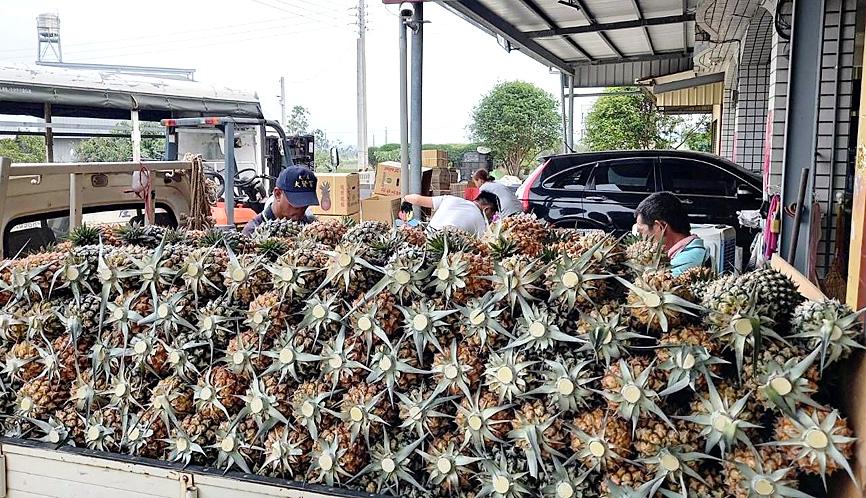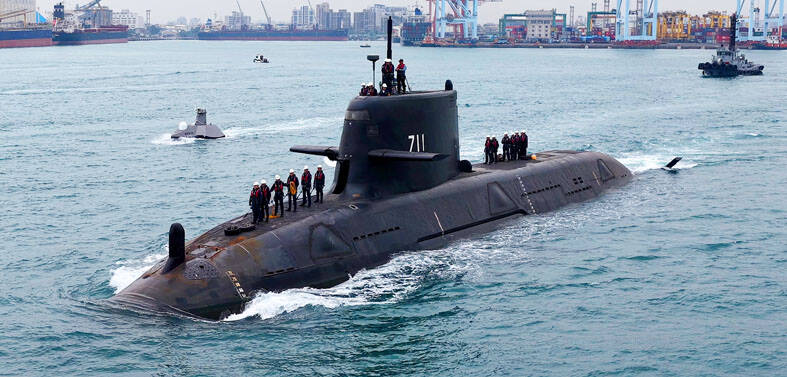Taiwan had exported 18,222 tonnes of pineapples this year as of Wednesday, with 61.9 percent sold to Japan, the Council of Agriculture (COA) said yesterday, adding that South Korea and the US are also new markets for the fruit.
After China suspended imports of Taiwanese pineapples from March, the council has worked to expand other export channels.
It aims to export 30,000 tonnes of pineapples this year, Department of International Affairs Director Lin Chia-jung (林家榮) said.

Photo: Hsieh Chieh-yu, Taipei Times
As of Wednesday, 18,222 tonnes of pineapples had been exported, including 11,286 tonnes (61.9 percent) sold to Japan, which exceeds the total sold to the country in the past decade, council data showed.
The amount exported to Japan is expected to continue rising, Lin said.
Japanese produce supplier Farmind last month purchased 3,000 tonnes of Taiwanese pineapples and sent fruit slices to supermarkets and convenience stores across the country, he said.
Meanwhile, the council is re-entering the South Korean market after a hiatus of a few years, he said.
South Korea used to import pineapples from the Philippines and Indonesia, but recently Seoul has shown a favorable response to Taiwanese pineapples, Lin said.
The council would work with some businesses to promote the fruit in South Korea, a prioritized market next year, he added.
As Taiwanese golden diamond pineapples are not suitable for long-distance transportation, the council would promote a mango-pineapple hybrid to countries farther away, Lin said, adding that the hybrid would be sold to Japan as well.
Some researchers have developed techniques to keep frozen golden diamond pineapples fresh even after they are defrosted, a source familiar with the matter said.
Such techniques would allow frozen golden diamond pineapples to be sold to the US next year, which would be another boon for exports, the person said.

NUMBERS IMBALANCE: More than 4 million Taiwanese have visited China this year, while only about half a million Chinese have visited here Beijing has yet to respond to Taiwan’s requests for negotiation over matters related to the recovery of cross-strait tourism, the Tourism Administration said yesterday. Taiwan’s tourism authority issued the statement after Chinese-language daily the China Times reported yesterday that the government’s policy of banning group tours to China does not stop Taiwanese from visiting the country. As of October, more than 4.2 million had traveled to China this year, exceeding last year. Beijing estimated the number of Taiwanese tourists in China could reach 4.5 million this year. By contrast, only 500,000 Chinese tourists are expected in Taiwan, the report said. The report

Temperatures are forecast to drop steadily as a continental cold air mass moves across Taiwan, with some areas also likely to see heavy rainfall, the Central Weather Administration (CWA) said. From today through early tomorrow, a cold air mass would keep temperatures low across central and northern Taiwan, and the eastern half of Taiwan proper, with isolated brief showers forecast along Keelung’s north coast, Taipei and New Taipei City’s mountainous areas and eastern Taiwan, it said. Lows of 11°C to 15°C are forecast in central and northern Taiwan, Yilan County, and the outlying Kinmen and Lienchiang (Matsu) counties, and 14°C to 17°C

SHIPS, TRAINS AND AUTOMOBILES: The ministry has announced changes to varied transportation industries taking effect soon, with a number of effects for passengers Beginning next month, the post office is canceling signature upon delivery and written inquiry services for international registered small packets in accordance with the new policy of the Universal Postal Union, the Ministry of Transportation and Communications said yesterday. The new policy does not apply to packets that are to be delivered to China, the ministry said. Senders of international registered small packets would receive a NT$10 rebate on postage if the packets are sent from Jan. 1 to March 31, it added. The ministry said that three other policies are also scheduled to take effect next month. International cruise ship operators

STEERING FAILURE: The first boat of its class is experiencing teething issues as it readies for acceptance by the navy, according to a recent story about rudder failure The Hai Kun (海鯤), the nation’s first locally built submarine, allegedly suffered a total failure of stern hydraulic systems during the second round of sea acceptance trials on June 26, and sailors were forced to manually operate the X-rudder to turn the submarine and return to port, news Web site Mirror Daily reported yesterday. The report said that tugboats following the Hai Kun assisted the submarine in avoiding collisions with other ships due to the X-rudder malfunctioning. At the time of the report, the submarine had completed its trials and was scheduled to begin diving and surfacing tests in shallow areas. The X-rudder,